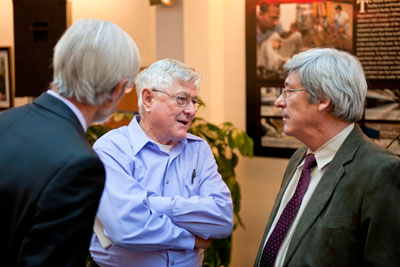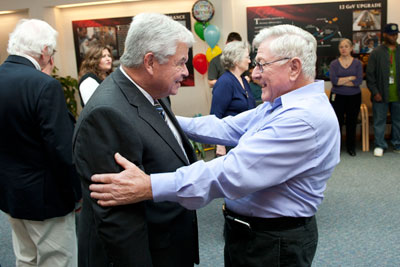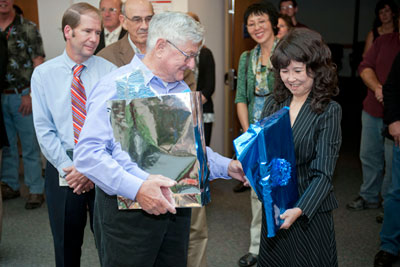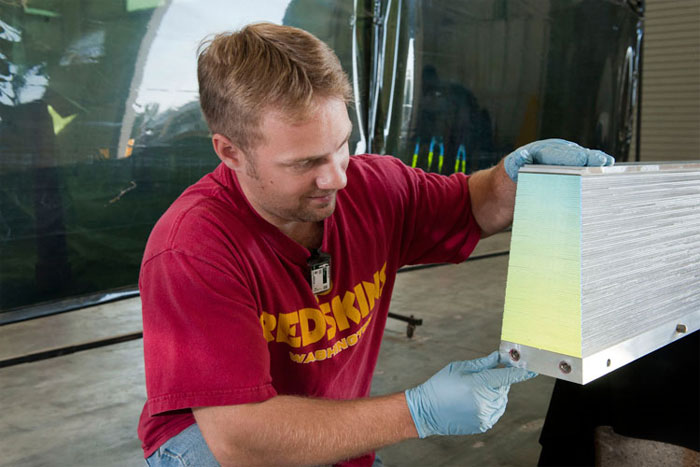
|
December 2011
|
|
|
The U.S. Department of Energy's Thomas Jefferson National Accelerator Facility
|
|
Injector Scientist Wins Lawrence Award |
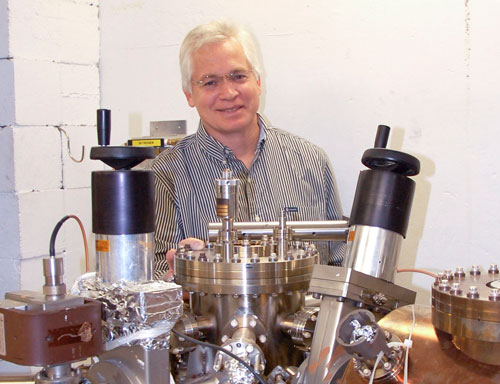 Matt Poelker, head of JLab's Center for Injectors and Sources, is one of nine winners of a 2011 Ernest Orlando Lawrence Award, a national-level award from the Department of Energy that recognizes scientists for their leadership role in research and development in support of DOE and its missions.
A Jefferson Lab scientist has been named recipient of a prestigious national award from the U.S. Department of Energy that recognizes his leadership role in research and development in support of DOE and its missions. Matt Poelker, a scientist with Jefferson Lab's Accelerator Division and head of the lab's Center for Injectors and Sources, was one of just nine winners of a 2011 Ernest Orlando Lawrence Award. Each winner receives a gold medal, a citation and $20,000. They also will be honored at a ceremony in Washington, D.C., early next year. "These researchers have made significant contributions to the national, economic, and energy security of the United States," Energy Secretary Stephen Chu said in a prepared statement. "I congratulate the winners and thank them for their work on behalf of the department and the nation."...... more |
|
|
Building Detectors to Study Plants
|
Refrigeration Recycling Keeps the Cold Coming for Experiments
|
Retrospective on Lab's Founding Director
|
||
|
|
||||
Below the Fold: |
||||
Injector Scientist Wins Prestigious 2011 Lawrence Award |
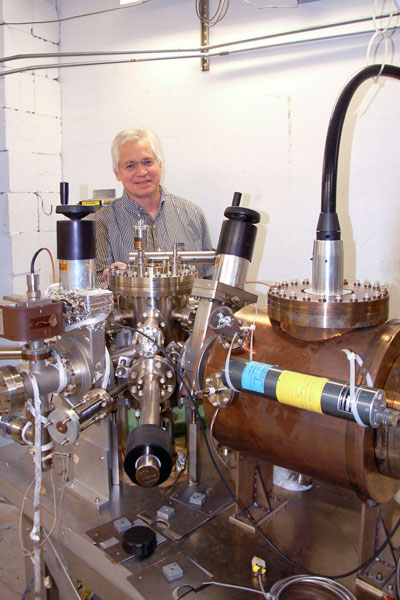 Matt Poelker
Center for Injectors and Sources A Jefferson Lab scientist has been named recipient of a prestigious national award from the U.S. Department of Energy that recognizes his leadership role in research and development in support of DOE and its missions. Matt Poelker, a scientist with Jefferson Lab's Accelerator Division and head of the lab's Center for Injectors and Sources, was one of just nine winners of a 2011 Ernest Orlando Lawrence Award. Each winner receives a gold medal, a citation and $20,000. They also will be honored at a ceremony in Washington, D.C., early next year. "These researchers have made significant contributions to the national, economic, and energy security of the United States," Energy Secretary Stephen Chu said in a prepared statement. "I congratulate the winners and thank them for their work on behalf of the department and the nation." The Lawrence Award was established in 1959 to honor the memory of Dr. Ernest Orlando Lawrence, who invented the cyclotron (a particle accelerator) and after whom two major DOE laboratories in Berkeley and Livermore, Calif., are named. Poelker received his award in the high-energy and nuclear physics category. He was recognized for leading a transformative effort to achieve production of electron beams possessing remarkable properties, advancing parity-violation and polarization-transfer experiments. Poelker and his Center for Injectors and Sources group develop and maintain the sources of electron beams for Jefferson Lab's CEBAF accelerator. The group has made great strides in providing record-current, highly polarized electron beams, in which the spins of the electrons are mostly aligned in one direction. Precision control of the electron beam's polarization can yield key information on the quark-gluon structure of nucleons, such as protons and neutrons. During a reception held at the lab on Nov. 28, Director Hugh Montgomery congratulated Poelker on receiving the award and commended Poelker and his group on their accomplishments. "It is my pleasure to congratulate Matt on behalf of the lab. Matt Poelker won the E.O. Lawrence Award for transformative work at JLab producing what we like to call parity beam, which is enabling some of the most beautiful experiments you have ever seen." "It is quite an honor and I appreciate the many warm sentiments and congratulatory notes I've received," Poelker said. "It's truly gratifying to learn that people appreciate the work that has gone into making the polarized electron beams at CEBAF." He praised his mentors and past and present supervisors for the knowledge they've passed on and the support they've given him over the years. He also acknowledged and thanked injector team members past and present and the many colleagues who have been a part of the advancements made by Poelker and the Injectors and Sources group. "Today's Source group is exceptionally clever and capable… I’m a lucky guy to work at CEBAF and I look forward to many more years of stimulating work. I hope I can live up to the expectations implicit in this award, and that as an institution, we can live up the public's expectation for continued discovery and greater understanding of our physical world." Poelker, a resident of Yorktown, joined Jefferson Lab in 1994. He received a B.S. in engineering physics from the University of Illinois at Urbana-Champaign and an M.S. and Ph.D. in electrical engineering from Northwestern University. The Lawrence Award
The Ernest Orlando Lawrence Award was established in 1959 in honor of a scientist who helped elevate American physics to world leadership. E. O. Lawrence was the inventor of the cyclotron, an accelerator of subatomic particles, and a 1939 Nobel Laureate in physics for that achievement. The Radiation Laboratory he developed at Berkeley during the 1930s ushered in the era of "big science," in which experiments were no longer done by an individual researcher and a few assistants on the table-top of an academic lab but by large, multidisciplinary teams of scientists and engineers using sophisticated equipment and huge scientific machines. During World War II, Lawrence and his accelerators contributed to the Manhattan Project, and he later played a leading role in establishing the U.S. system of national laboratories, two of which (Lawrence Berkeley and Lawrence Livermore) bear his name. The first Lawrence Awards were given in 1960. The award honors U.S. scientists and engineers, at mid-career, for exceptional contributions in research and development supporting the Department of Energy and its mission to advance the national, economic and energy security of the United States. It is given in each of the following eight categories: atomic, molecular, and chemical sciences; biological and environmental sciences; computer, information, and knowledge sciences; condensed matter and materials sciences; energy science and innovation; fusion and plasma sciences; high energy and nuclear physics; and national security and nonproliferation. The Lawrence Awards are administered by the Department of Energy's Office of Science. Over the years, the award has been presented to some of the most renowned scientists in their fields, including Nobel Laureates Richard Feynman and Saul Perlmutter. More about the award is available at: http://science.energy.gov/lawrence/ For more information about the Ernest O. Lawrence award, visit: http://science.energy.gov/lawrence/ The U.S. Department of Energy release, listing all of the winners, is available online: |
Building Detectors to Study Plants |
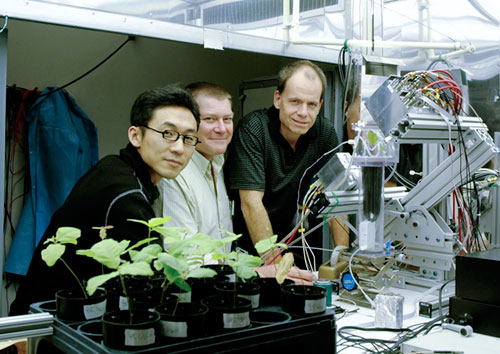 Detector group members Seungjoon Lee (left to right), Jack McKisson and group leader Drew Weisenberger examined the PhytoPET system they built during a visit to Duke University's Phytotron laboratory on Nov. 17.
Plants face all kinds of stress. Bugs chew on them, they get fungal infections, and they can get too hot or cold. So how do plants respond to stress? Members of Jefferson Lab's Radiation Detector and Imaging group are helping researchers at Duke University find out. The Duke University Phytotron is a laboratory built to study plants. The Phytotron has so-called Environmental Growth Chambers that allow researchers to control nearly every aspect of a plant's environment, from the nutrients it gets in the soil to the relative humidity and pollutants in the air. Fine-tuning individual aspects of a plant's surroundings can help researchers identify those aspects that can help or harm plants. While a plant's overall health can often be determined through simple observation, researchers sometimes need to see what's happening on the inside. That's where Detector group leader Drew Weisenberger and his colleagues come in. They are working to develop tools that can image inside plants. "It's at the point where biologists are kind of learning what we can provide and we're trying to learn what they need. So they have to learn a little physics and we have to learn a little biology. We're just trying to develop the tools and trying to get the tools to work," Weisenberger says. For instance, a study with the common barley plant addresses how it would respond to higher levels of carbon dioxide in the atmosphere. Green plants use CO2 in photosynthesis to create their own food. Researchers want to follow the path of carbon from the CO2 inside plants, from the moment it is breathed in by the plant, through its photosynthesis into sugars, to storage in the plant's roots. "We're just coming up with tools to help them quantify the physiology of photosynthesis under different conditions and parameters," Weisenberger adds. "They are also interested in studying invasive species and understanding how photosynthesis utilization and carbon dioxide utilization is different in various species," For the barley experiment, a special form of CO2 was generated at the Triangle Universities Nuclear Laboratory at Duke. The carbon atoms in this CO2 emit positrons, which are the anti-particles of electrons. When a positron encounters an electron in one of the atoms of the plant, the two particles annihilate each other and produce gamma rays. Those gamma rays can be detected by the Detector group's PhytoPET system. Entire Group Involved in Project
The entire Detector group has been involved in the plant imaging projects. While each member of the group focuses on specific aspects of the projects, everyone has provided hands-on assistance in multiple aspects. Team members are listed below with their respective areas of focus: Brian Kross: mechanical design and construction The PhytoPET system functions much like the PET scanners found in hospitals. One key difference is that the parts of the PhytoPET that collect the tell-tale gamma rays can be custom fit to the contours of a small plant. The building-block-inspired system is designed to give accurate information whether the blocks are arranged in a circular, semi-circular, flat or other configuration. The Duke researchers also want to better understand how plants respond to injury, such as that inflicted by a bug slowly munching on it or by some type of infection. A new study with an oak tree seedling has recently been undertaken to determine whether the plants tap the sugar stored in their roots to combat infection. "They introduce a fungus into the roots and see if that infected plant tries to deal with its infection. They didn't really have a way to measure that accurately, without destroying the plant," Weisenberger explains. Weisenberger and his colleagues designed a system that images the thin roots of plants. The new system, called PhytoBeta, is capable of detecting fast-moving positrons directly, allowing it to capture information from thin parts of the plant that may be missed by PhytoPET. What's more, PhytoPET and PhytoBeta can be used together to image all parts of plants, so biologists get the most information they can out of each experiment. Weisenberger says there's still much work to be done on the two systems, including making sure they meet the biologists' needs without interfering with experiments, such as making the new detectors highly reflective. "Inside a growth chamber, everything is aluminized. Biologists don't want you to cut off the light: They don't want to interfere with it. That's why we make our detectors reflective now, and that's kind of different from what we're used to," he notes. The work is supported by the Department of Energy's Office of Biological and Environmental Research. It builds on the group's many other projects, including breast imaging and small animal imaging that go beyond imaging subatomic particles produced in experiments at Jefferson Lab. By Kandice Carter For further reading, see: Getting Inside Plants at: https://www.jlab.org/news/articles/getting-inside-plants |
Refrigeration Recycling Keeps the Cold Coming for Experiments |
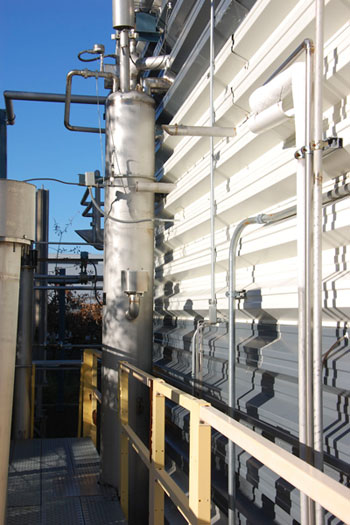 The Cryogenics group installed a system, known as a refrigeration recovery heat exchanger, at the End Station Refrigerator. The modification allows the Cryo group to recycle cooling capacity in the ESR to better support the cooling load needed for the most technically demanding experiments run with CEBAF.
Jefferson Lab has a long history of recycling, from used office paper and aluminum cans to the energy of used electrons. Now, the laboratory has added refrigeration to the list. Jefferson Lab has four cryogenic refrigerators on site. These refrigerators supply liquid helium to various systems to chill equipment to nearly absolute zero. In 2010, the Cryogenics group completed modifications to one of the refrigerators, the End Station Refrigerator, with a new component that allows it to recycle cooling capacity. "So, process-wise, what we're doing is we're recovering the refrigeration that would otherwise be wasted," explains Pete Knudsen, a member of the Cryogenics group staff and contributor to the project. The End Station Refrigerator supplies cryogenic helium to the experimental halls to keep superconducting magnets and various cryogenic targets cold. The modification allows the End Station Refrigerator to support the load for the most technically demanding experiment the laboratory has ever performed, Q-weak. The Q-weak experiment's goal is to very precisely measure the proton's so-called weak charge, a term that quantifies the influence that the weak force can exert on protons. To that end, Q-weak uses a high-power cryogenic hydrogen target to probe the lone proton in the hydrogen atom's nucleus. Without this modification, the End Station Refrigerator, or ESR, would not be capable of providing enough cooling capacity to run Q-weak in Hall C. "This modification, known as the refrigeration recovery heat exchanger, was envisioned by Rao Ganni and proposed to the Q-weak collaboration and to the Experimental Nuclear Physics Division in 2004," Knudsen explains. Rao Ganni is the Cryogenics group deputy and a principal staff engineer at Jefferson Lab. Previous High Target Load Support by ESR Since HAPPEx was scheduled to run for just 10 days, the modifications were to require a minimum capital investment, as requested by Jefferson Lab's Experimental Nuclear Physics Division. "What can we do for high demand for a short duration and low cost? At the time, we installed an inexpensive way to handle that," says Ganni. But the newfound capability was soon exploited beyond its original goal: it was routinely used to support many other high-load cryogenic targets in the experimental halls for very long durations. "This HAPPEx modification was wasteful of the helium refrigeration, as evident from the large ice-ball typically encompassing the outdoor evaporator," says Knudsen. Q-weak demands more At the time when the modifications for the refrigeration recovery heat exchanger were proposed, linear accelerator or linac operations had been optimized for providing the lowest radiofrequency system trip rate vs. energy for the accelerator, rather than an optimization that would lower the cryogenic load. If linac operations were re-optimized to balance the optimum accelerator energy, radiofrequency trip rate and cryogenic load, the load on the Central Helium Liquefier could be lowered, freeing up some capacity for use in the experimental halls. While the Accelerator Division and Cryogenics group tackled the accelerator optimization problem, the Cryogenics group also proceeded with plans for installing the refrigeration recovery heat exchanger, so that the lab could run Q-weak and also more efficiently supply other comparable high-load cryogenic targets in the future. In late 2006, partial funding was allotted to purchase the device. Knudsen then began a detailed process study. At the beginning of 2009, Errol Yuksek, another staff member of the Cryogenics group, began the mechanical design. By early 2010, the refrigeration recovery heat exchanger had been successfully tested and commissioned. "The actual performance tests very closely matched the capacity predictions and the anticipated component limits," Knudsen says. "The refrigeration recovery heat exchanger has been successfully supporting Q-weak since it began in 2010 and serves as a good example of inter-division cooperation for long-term experiment planning." According to the Cryogenics group, progress made in resolving the accelerator inefficiencies that affect the use of cooling capacity supplied to the CEBAF accelerator not only freed up enough capacity for the refrigerators to support Q-weak, but also compensated for unanticipated additional load associated with the Q-weak experimental hall cryogenic distribution system and the ability to provide cooling to cryogenic targets running simultaneously in the other two experimental halls, Halls A and B. The refrigeration recovery heat exchanger is just one example of the Cryogenics group's long-term commitment to proposing and implementing solutions for improving the efficiency of the cryogenic support systems whenever possible. "We want to minimize our utilities, without causing any harm to the support of the cryo loads. And we do it constantly," says Ganni. |
Injector Experiment to Test Feasibility of Producing Polarized Positrons…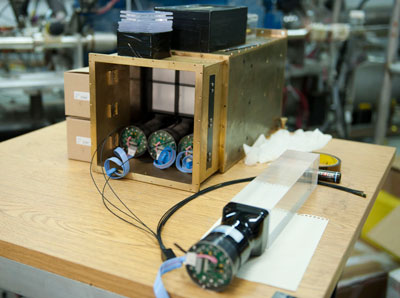 This brass box was used to assemble nine detectors for the calorimeter of the Compton transmission polarimeter to be used in the PEPPo experiment. Shown in the foreground is one of the detectors, a photomultiplier tube used to collect light from the cesium-iodide crystals that detect gamma rays generated from the electron or positron beam. Three more detectors are mounted in the box.
Erica Fanchini is an expert on pepperoni pizza and PEPPo. She shared her knowledge of both in a Pizza Seminar presentation at Jefferson Lab in August. So, what do the two have in common? Both require a precise recipe for the desired results. Fanchini, a postdoctoral researcher with the Joseph Fourier University and Laboratoire de Physique Subatomique et de Cosmologie in France, explained that PEPPo is the Polarized Electrons for Polarized Positrons experiment. Positrons are just like electrons, except that where the electron has a negative charge, the positron has a positive one. Physicists refer to the positron (e+), as the anti-particle of the electron (e-). Positrons (and electrons) gathered together into a bunch can be polarized, or made to spin in the same direction. "PEPPo is an experiment to test the feasibility to produce [sic] highly spin-polarized positrons from a polarized electron beam," she said. "The aim of the experiment is to measure the polarization as a function of the positron energy." Fanchini explained that before PEPPo, there were three methods that experimenters considered for producing a beam of polarized positrons for research. One method employs the magnetic field present in high-energy storage ring accelerators, while the other two bombard a fixed target with circularly polarized laser light. "But we have a new approach. In this case, we want to provide positrons in a different way," Fanchini said. The new method hinges on the CEBAF accelerator's ability to make a highly polarized, high-power beam of electrons. The electron beam will be sent into a target made of tungsten. The electrons are slowed as they travel through the tungsten, causing them to emit photons of light known as bremsstrahlung. "Bremsstrahlung is electromagnetic radiation produced by charged particles during deceleration or deflection," Fanchini explained. "The deceleration or deflection is due to the particles passing near the strong electric fields of atomic nuclei." Some of the bremsstrahlung photons almost immediately interact with the atoms in the tungsten, where their energy is converted into pairs of electrons and positrons. "This is the first attempt to transfer polarization from an intense polarized electron beam to a positron beam in a single target," Fanchini noted. A magnet will sweep away the electrons, while guiding the positrons into the next portion of the spectrometer, or detector system. A removable target will provide electrons for the positrons to interact with. When a positron meets an electron, the two particles annihilate, producing a tell-tale pair of photons that move in opposite directions. "The coincident detection of the 511 KeV photons will be one of the first signals that positrons are transported through the spectrometer," Fanchini said. Additional detector system elements will allow the team to further characterize the beam of positrons produced in the experiment, including the shape of the positron beam, the positron beam size and the number of positrons produced. It's expected that the positrons will exhibit roughly the same percentage of polarization as the original electron beam, about 85 percent. The researchers expect to detect about one positron for every one million electrons that enter their equipment, and most of the positrons are anticipated to have one-quarter the original electron energy. This experiment mixes a bit of the old with the new, as it builds on and partially borrows from previous experiments. Information about positron production, as well as some equipment, comes from the E166 experiment carried out at the SLAC National Accelerator Laboratory. Other detector components were originally used in the two-photon exchange experiment carried out in Jefferson Lab's Hall B. The entire experimental array is housed in the injector region of the CEBAF accelerator. Fanchini and her colleagues hope the information they gain from PEPPo will prove the feasibility of using a polarized electron beam to produce a polarized positron beam. If it works, it's the first step toward exploring the possibility of producing polarized beams of positrons for research with CEBAF. "For instance, a positron beam could be used to help us better our understanding of the relationship between quarks in the nucleon," Fanchini explained. Jefferson Lab's Program Advisory Committee approved the requested 14 days of beam from the CEBAF accelerator for the experiment to run. Researchers Prepare Hunt for New Forces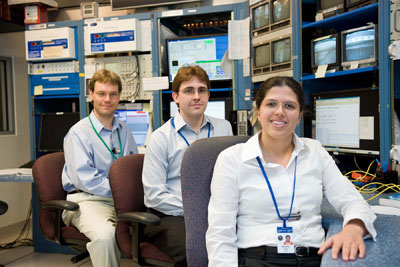 Co-spokespersons for the APEX experiment gathered for this photo after completing their test run on July 12, 2010. Pictured, left to right, are Philip Schuster, Perimeter Institute for Theoretical Physics; Natalia Toro, Perimeter Institute, and Rouven Essig, SLAC. JLab co-spokesperson for the collaboration (not pictured) is experimentalist and Hall A Staff Scientist Bogdan Wojtsekhowski.
Forces make and shape our universe, and for the past few decades humanity has been aware of and attempted to explain our universe through four forces. Work by Galileo and Sir Isaac Newton in the 16th and 17th centuries led to our understanding of gravity. James Maxwell's treatise in 1873 set the world on end explaining that electricity and magnetism were one force instead of two as was thought at the time. In the 20th century, scientists uncovered the weak force, which is responsible for the radioactive decay of subatomic particles, and the strong force which binds together quarks in protons and neutrons. Now a group of scientists affiliated with Jefferson Lab is hunting for previously undiscovered forces, and their tool of choice is the Continuous Electron Beam Accelerator Facility, or CEBAF. The collaboration of 60-plus researchers is planning an experiment using CEBAF that will search a specific energy and mass regime for signs of a force not previously identified. The force may not have been identified because it interacts with a different kind of matter – dark matter. A recent story published by the Perimeter Institute for Theoretical Physics, in Canada, tells of the group's latest work. The story is posted at: http://www.perimeterinstitute.ca/News/In_The_Media/PI_Science:_Hunting_for_New_Forces Results, from a test run carried out in CEBAF's Hall A during the summer of 2010, were recently published in Physical Review Letters: http://prl.aps.org/abstract/PRL/v107/i19/e191804 An article about this experiment published in the September 2010 On Target newsletter is posted at: Life's Trek Brings Scientist to U.S. from Nepal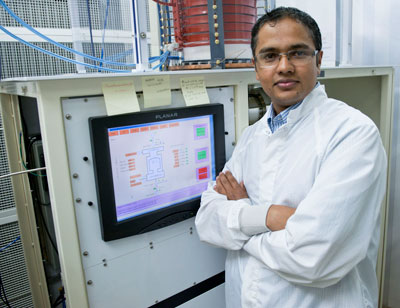 SRF Institute Scientist Pashupati Dhakal stands in front of the induction furnace used for heat treatment of niobium, superconducting radiofrequency cavities.
There were fewer than 1,000 people in the tiny Nepalese village of Tanahun district when Jefferson Lab SRF Scientist Pashupati Dhakal grew up there. He was the son of the village's school principal. And at that time, the local school only went through middle school. Had he stayed there, it would have been a two-hour trek by foot to the nearest high school. Instead, he moved in with his grandfather in Pokhara, a popular tourist destination in Nepal. "This," he said with a sweep of his hand toward a stunning computer screen shot of the Himalayas, "is the view I woke up to every morning." Impressive, indeed. Almost as impressive as Dhakal's abilities in math, which came to him early and were nurtured throughout his education. His first physics teacher at Tribhuvan University, where he did his undergraduate work, was, in Dhakal's words, "brilliant" and lured him into the field. "Studying with him made up my mind," he recalled. "That's when I said 'I want to be a physicist.'" He stayed on at Tribhuvan University for his master's degree, which he received in 2002, after presenting his dissertation titled, "Thickness Dependence of Chemical Potential in Degenerate Semiconductor." When he graduated, he had the highest score in the department and received a gold medal from Gyanendra Bir Bikran Shah Dev, the king of Nepal. Dhakal was offered a two-year teaching position for undergraduates and some graduate students while a professor went on sabbatical at the same department where he had completed his master's degree. "I learned even more by actually teaching physics," he noted. As that job was ending, he applied to 10 schools in the United States and had five offers. He chose Boston College, not only for its physics department, but because he wanted a cosmopolitan atmosphere, and he had a friend from Tribhuvan University that had preceded him there. "I'd seen enough mountains," Dhakal said with a laugh. "I was ready for a city." The flight from Nepal to the U.S. took 36 hours and brought him, literally, to the other side of the world. From what he knew about the U.S., he thought he'd be eating sandwiches all the time. Discovering Boston's ethnic groceries and restaurants was a relief. In fact, his friend's wife cooked him a traditional Nepalese meal on his first day. In graduate school, he was interested in condensed matter physics studying the very exotic properties of materials in ultra-cold temperatures and very high magnetic fields. Working with his Ph.D. supervisor, Michael Naughton, he became skilled in several experimental techniques as well as the theoretical knowledge on condensed matter physics. Dhakal finished his Ph.D. in August 2010 after presenting his dissertation, "Angular Magnetoresistance Oscillations in the Molecular Organic Conductor (DMET)2I3: Experiment and Calculation." In between there had been important business at home to tend to. In 2006, he returned to Nepal to meet, Sangita, the woman who would become his wife. In his culture, he explained, it is not a singular man and woman who are marrying, but the extended families. Sangita's brother-in-law and Dhakal's uncle were friends and thought they would make a perfect couple. In keeping with his home country's tradition, the couple met once and talked about their educations and plans for the future. "In western culture, you think love must come first, but we marry and let the love grow," he said fondly. When Dhakal joined Jefferson Lab's SRF Institute in the fall of 2010, Sangita stayed behind in Boston to finish her own education and received her nursing degree in December, after which she joined him here. Their daughter, Swarupa, is a few months old now. "She's one of the nicest babies," he crooned with a new father's smile, "and she's a good sleeper." Dhakal is teamed with scientists Gianluigi Ciovati and Ganapati Myneni – researching the superconducting properties of niobium, which he described as being "the heart and soul" of SRF, or superconducting radiofrequency technology. He is studying how it changes with heat and surface treatment procedures which are used during the fabrication of SRF cavities. The second part of his work involves researching ways to improve the quality factor of SRF cavities (Q0), which is limited by the so called residual loss. This means finding ways to reduce, eliminate or manage impurities and contaminates while fabricating and processing SRF cavities. "A new kind of clean, ultra-high vacuum induction furnace has been recently acquired to avoid contamination on niobium cavities during the heating process," he explained of a portion of the process necessary to prepare the cavities. "We have preliminary results, which look very good. They are showing signs of improvement." When evenings and weekends roll around, Dhakal enjoys following sports on TV. "I watch anything," he said with a laugh. Learning the American games was tricky; it took him a while to figure out that U.S. football players touch the ball with their hands instead of just their feet. His parents have been visiting, to help out with the new baby and Dhakal had the opportunity to take them to New York City. "I took them to the 86th floor of the Empire State Building and said to them, 'This is the real America.'" By Judi Tull JSA Awards Initiatives Fund Monies to Support Projects at JLab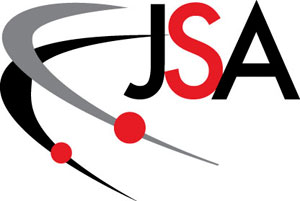 Jefferson Sciences Associates announced on Dec. 1 awards totaling $450,000 from the fiscal year 2012 JSA Initiatives Fund to support more than two dozen science projects tied to Jefferson Lab. JSA owners – the Southeastern Universities Research Association, or SURA, and CSC/ATG – established the Initiatives Fund to support programs, initiatives and activities that further the scientific outreach, and promote the science, education and technology missions of Jefferson Lab in ways that complement the lab's basic and applied research focus, according to the JSA news release announcing the awards. Twenty-six new projects received more than $324,000 in awards. Since mid-2006, JSA has made over 125 awards totaling $2.5 million. The program is managed and administered by SURA for the JSA Programs Committee. A complete listing of the FY2012 awards can be found at: www.jsallc.org/IF/IFProjects.html . The 2012 evaluation committee, chaired by JSA Programs Committee Chair June Matthews of MIT, included Elizabeth Beise, University of Maryland; Edward Brash, Christopher Newport University; Robert McKeown, Jefferson Lab; Zein-Eddine Meziani, Temple University; Zisis Papandreou, University of Regina; Daniel Sober, The Catholic University of America; and Elizabeth Lawson, SURA/JSA. JSA President and Jefferson Lab Director, Hugh Montgomery, said, "These diverse projects and initiatives, many of which leverage the commitments of others, add value to the lab's programs and help to cultivate the support of the science and user communities." JSA Programs Committee Chair June Matthews commended JSA owners for their continued monetary support for the Initiatives Fund Program and noted, "In addition to seed funding projects, the Initiatives Fund Program has proven to be a valuable resource for important on-going initiatives such as the K-12 education program and graduate fellowships." In accepting the recommendations of the evaluation committee, JSA co-owner, SURA President and CEO, Jerry Draayer, noted, "Our CSC co-owners and I believe that our investment in the Initiatives Fund Program has been beneficial in providing the means that enable the lab and its users to engage in educational, scientific, technical, and outreach activities that may otherwise not have been accomplished." JAG Announces Holiday Events, Activities"The holidays will be here in the blink of an eye. Plan on being part of the fun and festivities being planned for Jefferson Lab staff, users, family members and subcontractors," urges Jefferson Activities Group Chair Bridget Paul. "Mark your calendars. Look for the fliers in your work areas, visit the JAG webpage or contact a JAG committee member for more information. Please bring in a Toys For Tots donation or support a charity of your choice to help those in our community who are having a difficult time. The JAG committee wishes everyone at the lab a happy and safe holiday season."  Volunteers are needed to help with the JAG Children's Holiday Party on Saturday, Dec. 10. Volunteers are needed at the crafts-table to assist younger children with basic cutting, gluing or tying and as game helpers. All crafts and supplies will be provided. Volunteers are also needed for the snack area and as Santa's Helpers. Sign up now online at: https://mis.jlab.org/ul/apps/volunteer/form.cfm?id=58
JLab Youth Invited to Children’s Holiday Party Volunteers Needed to Help With Children’s Party Toys For Tots Toy Drive Underway The deadline for bringing in donations is noon Saturday, Dec. 10. A Toys For Tots representative will pick up the donations Saturday afternoon. Marked drop boxes are located near the main entrances of CEBAF Center, VARC, ARC, Test Lab and the MCC. For information about the Toys for Tots program, visit: www.toysfortots.org. Ready, Set, Hang Those Decorations Milestones for October 2011Hello Goodbye These Milestone entries, listed alphabetically, are full-time, term, casual and student actions posted by Human Resources for October 2011. Jefferson Lab is currently seeking qualified individuals for a range of positions. More than 15 engineering, technician and scientific employment opportunities are currently posted at: [Link Removed] In Memoriam:
|
|
The On Target newsletter is published monthly by the Thomas Jefferson National Accelerator Facility (Jefferson Lab), a nuclear physics research laboratory in Newport News, Virginia, operated by Jefferson Science Associates, LLC, for the U.S. Department of Energy's Office of Science. Possible news items and ideas for future stories may be emailed to jlabinfo@jlab.org, or sent to the Jefferson Lab Public Affairs Office, Suite 15, 12000 Jefferson Avenue, Newport News, VA 23606
|


 Plants face all kinds of stress. Bugs chew on them, they get fungal infections, and they can get too hot or cold. So how do plants respond to stress?.......
Plants face all kinds of stress. Bugs chew on them, they get fungal infections, and they can get too hot or cold. So how do plants respond to stress?....... Jefferson Lab has a long history of recycling, from used office paper and aluminum cans to the energy of used electrons. Now, the laboratory has added refrigeration to the list.......
Jefferson Lab has a long history of recycling, from used office paper and aluminum cans to the energy of used electrons. Now, the laboratory has added refrigeration to the list....... When Hermann Grunder was asked to leave Lawrence Berkeley National Lab and become the director of a fledgling lab in Newport News, in 1985, it was a risk. But risk was something familiar to Hermann.......
When Hermann Grunder was asked to leave Lawrence Berkeley National Lab and become the director of a fledgling lab in Newport News, in 1985, it was a risk. But risk was something familiar to Hermann.......